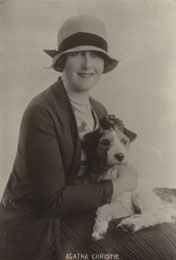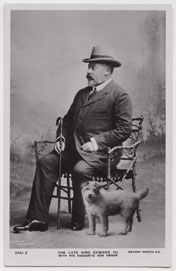Pets in Portraits
Daughter of Lord Sackville and brought up at Knole, one of the largest country houses in England, the writer Vita Sackville-West is better known for her unconventional marriage to the diplomat Sir Harold Nicolson and for the creation of the garden at Sissinghurst. The dignified and monumental combination of the statuesque figure, the ancient arch and urn and the noble dog conceals a hidden tragedy, for Martha, the German shepherd dog, was already dying. Vita’s companion of 13 years, later that year he had suffered a heart attack. Harold had arrived to ‘find Viti [sic] pacing by the lake in an agony of tears’.
DUCHESS OF WINDSOR WITH DIZZY Dorothy Wilding, 1955
Dizzy (short for Disraeli) was the first of nine Windsor pugs and joined the Duke and Duchess’s household in France soon after their return from wartime governorship of the Bahamas in 1945. They took to pugs with something of an obsession. In the sale catalogue of the Windsors’ effects were several silverplated dog bowls, engraved collars, pug bed linen and a whole host of ‘puggiana’, including paintings and Meissen figurines. This photograph was taken in Dorothy Wilding’s studio in New York, where the Windsors had an apartment and where their pugs were often proudly paraded in national dog shows.
 Anna Pavlova with Jack
Anna Pavlova with JackMADAME YEVONDE Self-portrait, c. 1958
Madame Yevonde was one of the most original figures in British photography. Her pioneering work with colour photography in the 1930s was extremely influential and this entertaining self-portrait is typical of her always inventive approach and surely indicative of the importance cats played in her life. Her cats seemed to increasingly fill the void left by her husband’s death and they had a free run of her studio. Whiskey wormed his way into several of her society portraits in the 1930s, and it was probably he who escaped with her to safety seconds before a direct hit on her Berkeley Square studio during the Blitz. Junior also appears in other photographs. On the reverse of the mount, Mme Yevonde has inscribed: ‘JUNIOR – Winner of the 1958 Good Conduct Prize offered by the Cats Protection League for the most distinguished cat. He was aged 18 when he disappeared. He is wearing a very early photograph of the photographer.’
 Agatha Christie
Agatha Christie ANNA PAVLOVA WITH JACK Lafayette, 1927
Russian prima ballerina Anna Pavlova’s most famous solo was The Dying Swan, and an admirer presented her with a pair of swans, Jack and his mate, who arrived soon after she moved in to her house, Ivy House, in 1913, with its specially enlarged lake. Jack became quite tame and his family increased rapidly from two to eight… [Pavlova] would take him on her knees and twine his neck around hers and Jack would take it all without the slightest protest.
AGATHA CHRISTIE Unidentified press photographer, 1920
Christie very clearly wanted her canine companion in the picture. This is a photograph of the novelist and her dog, not of her and a dog. This is no surprise. She had loved dogs from an early age, kept them all her life and described very possibly the cheeky chap in this image, a wire-haired terrier called Peter, as ‘a dog in a thousand’. She even dedicated one of her 66 novels to him. And it’s this clear connection, her obvious affinity with her dog, that makes this portrait successful.
 King Edward VIIELLEN TERRY William Henry Grove, 1889
King Edward VIIELLEN TERRY William Henry Grove, 1889Ellen Terry owned several fox terriers, Fussie was her first and she had acquired him from the famous jockey Fred Archer in the mid-1880s and, since he was the first fox terrier she had owned, it may reasonably be assumed to be one of the two being tempted with titbits by his mistress, apparently on a stage set. The other is probably Drummy or Bossy. She shared Fussie with her acting partner Henry Irving, and he drank champagne from ‘ladies fingers’, and had his own chair in Irving’s dressing room.
KING EDWARD VII Thomas Heinrick Voigt, c. 1910
Though better remembered for a number of famous mistresses, one of the most constant and faithful companions of Edward VII’s last years was a small terrier called Caesar. As can be seen from the numerous retouchings around the dog, the photograph is in fact a fake, in which Caesar, who wore a collar inscribed ‘I am Caesar, the King’s dog’, was reunited with his master and the result issued as a postcard by an enterprising German photographer after the King’s death in 1910.
Caesar shot to fame at the King’s funeral when he was delegated by Queen Alexandra to follow the coffin in the procession from Westminster Hall on its way to Windsor.
Pets In Portraits, by Robin Gibson (National Portrait Gallery, £10).
All images are courtesy of the National Portrait Gallery.



